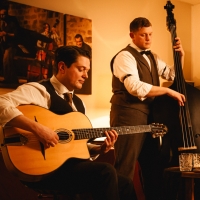DjangoBooks.com
Welcome to our Community!
Categories
- 17.9K All Categories
- 396 General
- 257 Welcome
- 10 Archtop Eddy's Corner
- 74 CD, DVD, and Concert Reviews
- 29 FAQ
- 9 Gypsy Jazz Italia
- 17 Photos
- 24 Gypsy Picking
- 3 Unaccompanied Django
- 1 Pearl Django Play-Along Vol.1
- 1 Gypsy Fire
- 21 Gypsy Rhythm
- 551 Gypsy Jazz University - Get Educated
- 104 Gypsy Jazz 101
- 175 Repertoire
- 128 History
- 88 Technique
- 39 Licks and Patterns
- Daniel Givone Manouche Guitare Method Users Group
- 17 Eddie Lang Club
- 1K Gypsy Jazz Gear
- 648 Guitars, Strings, Picks, Amps, Pickups and Other Accessories
- 316 Classifieds
- 36 Recording
- 38 Other Instruments
- 17 Violin
- 3 Mandolin
- 6 Accordion
- 3 Bass
- 9 Woodwinds
- 197 Gypsy Jazz Events
- 78 North America
- 81 Europe
- 38 International
In this Discussion
neck size for smallish hands
hi, I was lucky enough to find a local luthier who can build me a Gypsy guitar at a special price. he uses original Selmer plans, and has apparently been building Gypsy guitars for UK and US buyers for more than a decade now. he was happy to hear that someone who's local is playing GJ and offered me a great deal to help me out.
OK, so since his guitars are 1:1 copies of the original Selmer, the neck is somewhat thick. I never was comfy with classical sized necks given my smallish hands (and stubby fingers). I've been reading here about neck sizes and though some prefer narrow necks, the majority prefer wider ones albeit thinner (C-shaped IIRC). I initially asked if the neck of my guitar be built Ala modern epiphone acoustic guitars - narrow with a soft V-shape - but now I'm wondering if I'm better off with a wider but thinner neck (c- or maybe v-shaped).
my question, should I have a narrow and thin neck made, or should I go for the wide but thin kind? does it really make a huge difference in sound and tone? what's the middle ground in terms of neck size? I don't often hear about V-shaped necks, only c- or d-shaped, how do you guys feel about V-shaped necks?
thanks!
OK, so since his guitars are 1:1 copies of the original Selmer, the neck is somewhat thick. I never was comfy with classical sized necks given my smallish hands (and stubby fingers). I've been reading here about neck sizes and though some prefer narrow necks, the majority prefer wider ones albeit thinner (C-shaped IIRC). I initially asked if the neck of my guitar be built Ala modern epiphone acoustic guitars - narrow with a soft V-shape - but now I'm wondering if I'm better off with a wider but thinner neck (c- or maybe v-shaped).
my question, should I have a narrow and thin neck made, or should I go for the wide but thin kind? does it really make a huge difference in sound and tone? what's the middle ground in terms of neck size? I don't often hear about V-shaped necks, only c- or d-shaped, how do you guys feel about V-shaped necks?
thanks!












Comments
My current GJ guitar has a relatively thin neck and a squared off top and bottom (staple shape) and is fairly comfortable. However, I recently played a Vladimir guitar in which the back of the neck is thicker, more rounded. Without a doubt, it felt more comfortable for me to play. And playing it in a jam, I noticed that it wasn't as loud as my GJ guitar, but I really couldn't get a sense of of its subtleties. Was I getting an annoying buzz? I couldn't tell. Another person in the jam thought that my guitar was easier to play.
Different hands and differences in the way we play with our hands (and our bodies) will make the difference in which necks are most comfortable. The only to really know is to go out there and spend the bucks to get you to places where you can test out a large selection of guitars.
In the autumn of 2013, I bought an Eimers Antique. The difference is night and day for me. The fretboard is so much more comfortable to my hands.
To me, the width and thickness of the neck is not what makes the big difference, although it matters.
What made everything easier for me is shorter distance between frets so I didn't have to stretch so much.
Swang on,
If you are on the quest for a perfect neck, you should probably measure necks you like. A builder can give you a very close approximation if they know:
Measurements will require calipers and/or a micrometer. If the strings on are the neck you are measuring, you will need a measured spacer to get the caliper over the strings to measure thickness, then subtract the spacer thickness for the actual thickness. Measurements should be within 1/32" or 0.5mm.
Something I've been doing recently is adding a little inward cant to the fingerboard to ease the edge some. This helps with thumb overs and wider necks. When finished it is a smooth rounded transition with the widest part of the neck at the base of the fingerboard and is more comfortable.